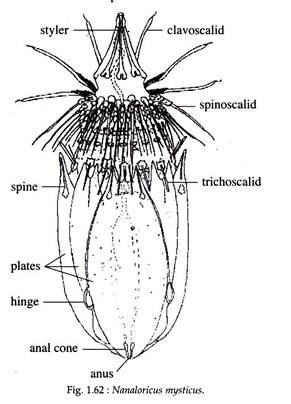In this article we will discuss about Phylum Loricifera:- 1. Introduction to Phylum Loricifera 2. Diagnostic Features of Phylum Loricifera 3. Scheme of Classification.
Introduction to Phylum Loricifera:
Loricifera, described by the Danish zoologist, R. M. Kritensen in 1983, is by far the most recently discovered phylum. They comprise of minute animals, about 250 µm in length, that lives in the interstitial spaces of shelly, marine gravel at depths from 15 to almost 8300 m.
Members of the phylum have been collected from many places around the world, but they have not been observed alive and current knowledge about them is based solely on preserved specimens. These animals adhere so firmly to the gravel substrate that they cannot be removed easily, which probably accounts for their late discovery.
Etymology:
ADVERTISEMENTS:
Latin: Lorica, a breastplate or corselet; ferre, to bear.
Diagnostic Features of Phylum Loricifera:
i. Bilaterally symmetrical minute body.
ii. Body more than two cell layered thick, with tissues and organs.
iii. Body with three regions — head, neck and trunk.
ADVERTISEMENTS:
iv. The cone shaped anterior end is the eversible head or introvert that bears many re-curved spines (scalids) on its lateral surface.
v. At the end of the introvert is the telescopic mouth surrounded by eight oral stylets.
vi. Neck region short, externally segmented, bearing rows of plates.
vii. The major part of the body is the trunk or abdomen, which is encased within a cuticular lorica composed of a dorsal, a ventral and two lateral plates.
ADVERTISEMENTS:
viii. The head and neck are retractable into the lorica.
ix. Presence of a straight gut and a terminal anus.
x. Gut with a large, muscular pharyngeal bulb and a telescopically extrusible buccal canal, whole gut possibly lined with cuticle.
xi. Excretory system formed of one pair of protonephridia.
xii. Nervous system comprises of a large brain (lying within the introvert) and ganglionated ventral nerve cord.
xiii. Sexes separate, each with a pair of gonad.
xiv. A larval (Higgins larva) stage is present, somewhat similar to the adult except that the buccal cone lacks stylets and the thorax lacks spines.
Scheme of Classification of Phylum Loricifera:
There are over 100 loriciferan species known, most of them yet un-described (R. S. K. Barnes, 1988). A single order Nanaloricida, is currently recognised that comprises of three families.
Example: Nanaloricus (Fig. 1.62).
